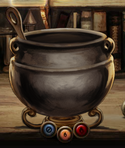

A Cauldron is a vessel used in the brewing of potions. Brewing speed depends on the cauldron material.
Wizards can buy a different variety of cauldrons in Potage's Cauldron Shop, in Diagon Alley. The prices range from 15 to 25 galleons. Pottermore users can buy all three, but cannot have more than one of each.
Types[]
Pewter[]
The most common type of cauldron, and the cheapest. The Pewter Cauldron can be purchased at the price of 15 galleons. It is the slowest at brewing potions.
Brass[]
The Brass Cauldron is the second most expensive and can be purchased at the price of 21 galleons. It is the second fastest at brewing potions.
Copper[]
The Copper Cauldron is the most expensive cauldron, priced at 25 galleons. It is the fastest at brewing potions.
Brewing[]

A melted cauldron
When making potions, ingredients are added to the cauldron, sometimes after being crushed in the Pestle and mortar. The cauldron must be kept at the right temperature using the buttons below the cauldron on the brewing page; if the temperature is too high or too low, the cauldron will explode and the potion maker will lose five points. When a cauldron melts, it cannot be reused and the potion maker must replace it with a new one from Potage's Cauldron Shop.
Gallery[]
Cauldron Time Chart[]
As mentioned, pewter is the slowest, then brass, then copper. The times don't change at the same percent, though. Here's a chart at the differences in times. Please correct any mistakes you notice:
|
Potion |
Pewter Cauldron Time |
Brass Cauldron Time |
Copper Cauldron Time (Compared to Pewter) |
|---|---|---|---|
|
Antidote to Common Poisons |
40 |
34 (15% Decrease) |
30 (25% Decrease) |
|
Cure for Boils |
45 |
39 (13% Decrease) |
34 (24% Decrease) |
|
Forgetfulness Potion |
60 |
51 (15% Decrease) |
45 (25% Decrease) |
|
Herbicide |
60 |
51 (15% Decrease) |
45 (25% Decrease) |
|
Sleeping Draught |
70 |
60 (14% Decrease) |
53 (24% Decrease) |
|
Wideye or Awakening Potion |
55 |
47 (14.5% Decrease) |
42 (24.5% Decrease) |
New from J.K. Rowling[]
Cauldrons were once used by Muggles and wizards alike, being large metal cooking pots that could be suspended over fires. In time, magical and non-magical people alike moved on to stoves; saucepans became more convenient and cauldrons became the sole province of witches and wizards, who continued to brew potions in them. A naked flame is essential for the making of potions, which makes cauldrons the most practical pot of all.
All cauldrons are enchanted to make them lighter to carry, as they are most commonly made of pewter or iron. Modern inventions include the self-stirring and collapsible varieties of cauldron, and pots of precious metal are also available for the specialist, or the show-off.
J.K. Rowling's thoughts[]
Cauldrons have had a magical association for centuries. They appear in hundreds of years' worth of pictures of witches, and are also supposed to be where leprechauns keep treasure. Many folk and fairy tales make mention of cauldrons with special powers, but in the Harry Potter books they are a fairly mundane tool. I did consider making Helga Hufflepuff's hallow a cauldron, but there was something slightly comical and incongruous about having such a large and heavy Horcrux; I wanted the objects Harry had to find to be smaller and more portable. However, a cauldron appears both in the four mythical jewels of Ireland (its magical power was that nobody ever went away from it unsatisfied) and in the legend of The Thirteen Treasures of Britain (the cauldron of Dyrnwch the giant would cook meat for brave men, but not for cowards).
Trivia[]

The Self-Stirring Cauldron
On Pottermore at Playstation Home, a Self-Stirring Cauldron can be seen outside of Potage's Cauldron Shop.



